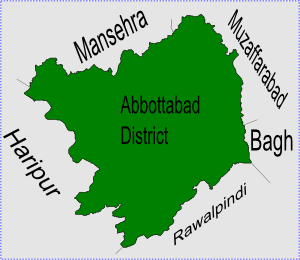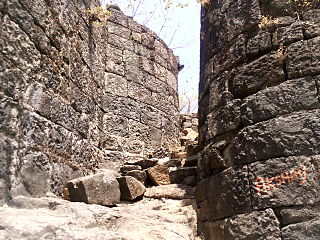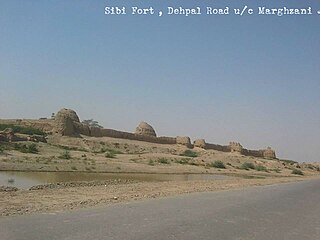Dehpal Kalan

The Dehpal [1] Kalan is a village near Sibi city of Balochistan Province of Pakistan
Contents

The Dehpal Panni Tribe lived in the Ancient Sibi Fort for many years. [2]

The Dehpal [1] Kalan is a village near Sibi city of Balochistan Province of Pakistan

The Dehpal Panni Tribe lived in the Ancient Sibi Fort for many years. [2]
The ancient Fort of Sibi is situated in Dehpal Kalan village near Sibi city. It finds place in popular Chach Nama where it is narrated that the King Chach defeated Sewas pushing out of this place and captured Sibi Fort.The Hindu rulers Sewas kept control for considerable time ultimately lost to king Chach in 550 A.D. The Arab General Muhammad bin Qasim say whole of this area. During the 11th century Sibi included in Ghaznavid Empire. Sibi Fort was fief of Jam Nizamuddin II of Sindh in 1488 A.D. the end of 15th century Sibi Fort was captured by Shah beg Arghun rebuilt the huge dome shaped architecture which still exists. In 1575 A.D. decaying of Arghun dynasty the Panni tribe taken control of Siwi Fort. The Government records evidence shows that Dehpal a Panni (Pashtun tribe) lived in Sibi Fort and possess the land adjacent to the Fort, a village Dehpal Kalan is situated near the Fort.

Makran, also mentioned in some sources as Mecran and Mokrān, is the southern coastal region of Balochistan. It is a semi-desert coastal strip in the Balochistan province in Pakistan and in Iran, along the coast of the Gulf of Oman. It extends westwards, from the Sonmiani Bay to the northwest of Karachi in the east, to the fringes of the region of Bashkardia/Bāšgerd in the southern part of the Sistan and Baluchestan province of modern Iran. Makrān is thus bisected by the modern political boundary between Pakistan and Iran.

Chandrapur is a city and a municipal corporation in Chandrapur district, Maharashtra state, India. It is the district headquarters of Chandrapur district. Chandrapur is a fort city founded by Khandkya Ballal Sah, a Gond king of the 13th century. The city sits at the confluence of the Erai river and Zarpat river. The area around the city is rich in coal seams.. Hence, Chandrapur is also known as the "Black Gold City".

Kekaya was an ancient Indo-Aryan tribe of north-western South Asia whose existence is attested during the Iron Age. The members of the Kekaya tribe were called the Kaikayas.

Ghazipur district is a district of Uttar Pradesh state in northern India. The city of Ghazipur is the district headquarters. The district is part of Varanasi Division. The region of Ghazipur is famous mainly for the production of its unique rose-scented Spray called Gulab Jal, and for the tomb of the Governor General of British India, Lord Cornwallis, who died here. His tomb is situated in Western part of City, and is conserved by Archaeological Survey of India.

The Samma dynasty was a medieval Sindhi dynasty ruled by the Samma tribe of Sindh in the Indian subcontinent, that ruled Sindh, as well as parts of Kutch, Punjab and Balochistan from c. 1351 to c. 1524 CE, with their capital at Thatta known as Sammanagar in modern day Sindh, Pakistan; before being replaced by the Arghun dynasty.

Sibi is a district in the Balochistan province of Pakistan. The main mountain ranges are Zen, Bambore and Dungan. The climate and topography of Sibi District is quite varied as compared to other districts of Balochistan. It is also known as the "Hot spot" of Pakistan where the temperatures in the summer exceed 52.6 °C (126.7 °F). Until 2013 the district had two sub-divisions, Sibi and Lehri, further organized into Tehsils and sub-tehsils: Sibi, Lehri, Kutmandi and Sangan. Lehri was rejoined with Sibi district in 2018.
Sibi is a city situated in the Balochistan province of Pakistan. The city is the headquarters of the district and tehsil of the same name.
Raja Dahir was the last Hindu ruler of Sindh. A Brahmin ruler, his kingdom was invaded in 711 CE by the Arab Umayyad Caliphate, led by Muhammad bin Qasim, where Dahir died while defending his kingdom. According to the Chachnama, the Umayyad campaign against Dahir was due to a pirate raid off the coast of the Sindhi coast that resulted in gifts to the Umayyad caliph from the king of Serendib being stolen.

The area of Karachi in Sindh, Pakistan has a natural harbor and has been used as fishing port by local fisherman belonging to Sindhi tribes since prehistory. Archaeological excavations have uncovered a period going back to Indus valley civilisation which shows the importance of the port since the Bronze Age. The port city of Banbhore was established before the Christian era which served as an important trade hub in the region, the port was recorded by various names by the Greeks such as Krokola, Morontobara port, and Barbarikon, a sea port of the Indo-Greek Bactrian kingdom and Ramya according to some Greek texts. The Arabs knew it as the port of Debal, from where Muhammad bin Qasim led his conquering force into Sindh in AD 712. Lahari Bandar or Lari Bandar succeeded Debal as a major port of the Indus; it was located close to Banbhore, in modern Karachi. The first modern port city near Manora Island was established during British colonial Raj in the late 19th century.

Bijoliya is a census town in Bhilwara district in the state of Rajasthan, India and is surrounded by nature and waterfalls and is famous for Tapodaya Teerth Kshetra and Mandakini Temple.
Chach was a Hindu Brahmin king of Sindh region of the Indian subcontinent in the mid-7th century AD. Chach expanded the kingdom of Sindh, and his successful efforts to subjugate surrounding monarchies and ethnic groups into an empire covering the entire Indus valley and beyond were recorded in the Chach Nama.

Balochistan is a historical region in Western and South Asia, located in the Iranian plateau's far southeast and bordering the Indian Plate and the Arabian Sea coastline. This arid region of desert and mountains is primarily populated by ethnic Baloch people.

Sherwan is a Tehsil from the Abbottabad District in the Khyber-Pakhtunkhwa province of Pakistan, located 35 km west of Abbottabad. Sherwan consists of two adjacent villages. The northern part is referred to as Sherwan Kalan, and the southern as Sherwan Khurd. Sherwan is on a ridge 5,000 feet high in the centre of Lower Tanawal.
Nasir al-Din Abu al-Fatah Firuz Shah II, commonly known as Jam Feroz (1508–1524/5), was the last ruler of the Samma dynasty of Sindh. Jam Feroz proved himself a weak ruler and lost his kingdom to Arguns, thus Sindh came under foreign rulers.

Mansura, referred to as Brahmanabad in later centuries, was the historic capital of the caliphal province of Sindh, during the eighth century under the Umayyad Caliphate and then Abbasid Caliphate from the year 750 AD to 1006 AD. The city was founded as a central garrison by the Umayyad Forces in Sindh, the city transformed into a very vibrant metropolis during the Abbasid Era surpassing the wealth of Multan in the north and Debal in the south. Mansura was the first capital established by the Muslims in the Indian subcontinent after Muhammad bin Qasim seized the Brahmanabad territory. Mansura was built on the shores of the Indus River, it was surrounded by fertile farmland, Ibn Hauqal mentioned the wealthy local merchants who wore Baghdad Costume and were of Sindhi-Arab origins, houses were made of clay, baked bricks and plaster.
Luni,, pronounced "Looni", is a village in the Balochistan province of Pakistan. It is located about 11 kilometres (6.8 mi) north of the city of Sibi in Sibi District of Balochistan Province, at an altitude of 495 feet (151 m).

Mangad Fort is a survey fort which is situated in Borwadi, an area near Mashidwadi in Mangaon, a taluka in Raigad district in the Indian state of Maharashtra. The fort is made sacred by the footsteps of the founder of Hindavi Swaraj, the famous Maratha king Chhatrapati Shivaji Maharaja. Mangaon is situated about 150 km from Mumbai.
The Khajjak is a village at a 8 kilometers distance from Sibi city of Balochistan, Pakistan. The whole of the Khajjak town is very rich particularly in wheat. The Khajjak tribe hold the means of irrigation by the Nari completely in their hands and their crops extent of cultivation were unequaled in any part of Kachhi District.
Marghzani tribe is one of prominent tribes of Sibi and Musakhail. The tribe itself a tribe of Panni Pashtoons.The tribe as per their background must have spoken Pashto as those belonging to Musakhail do speak but those living in areas of Sibi speak Sindhi.Sibi is famous for its diversity where each ethnic group despite their background speaks Sindhi. there are several villages of Marghazani tribe in sibi while located and named according to their subgroups.For instance,Mullazai,Khankhails,Samezai, shudonzai Bostanzai and many more.

The Sibi Fort is situated in Sibi city of Balochistan Province, Pakistan.